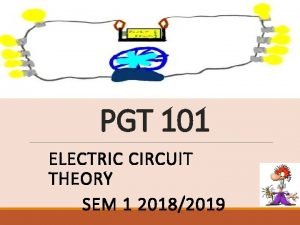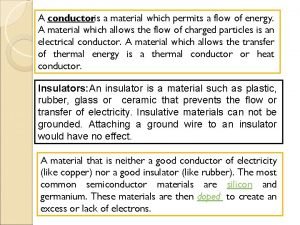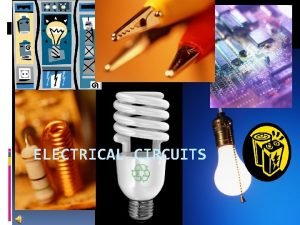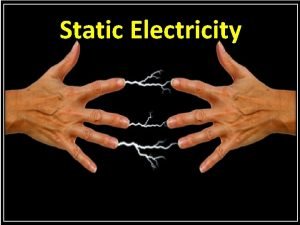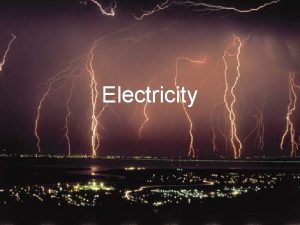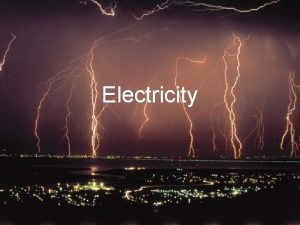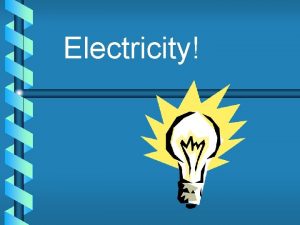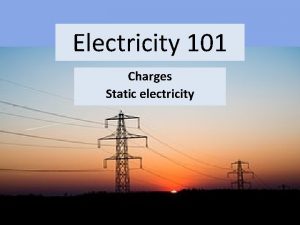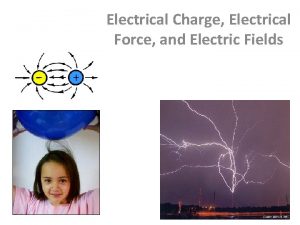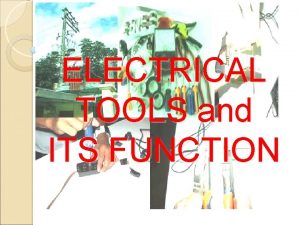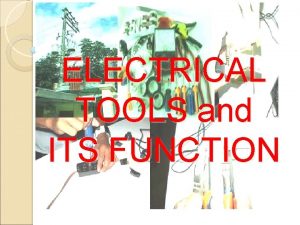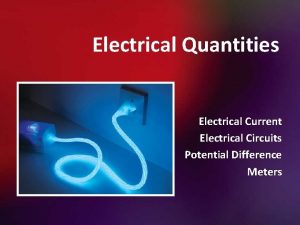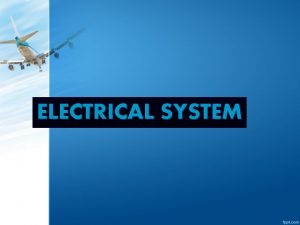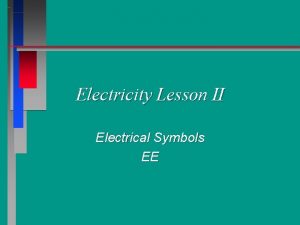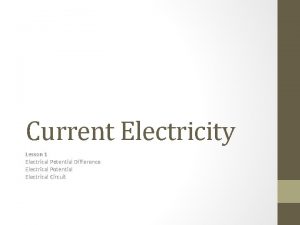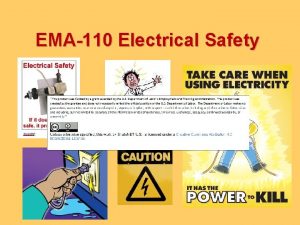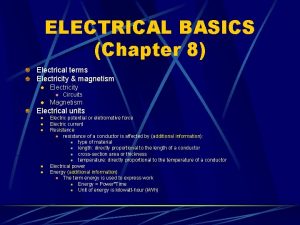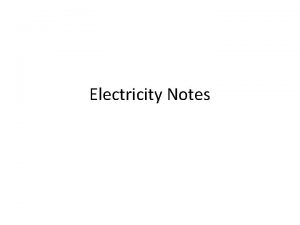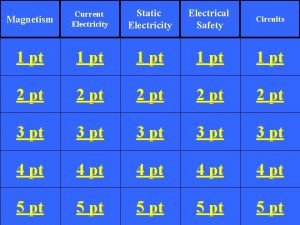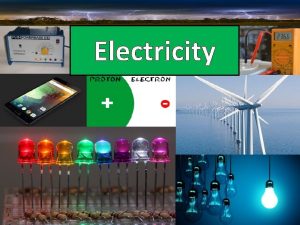Electricity 101 Electricity is the flow of electrical










































- Slides: 42


Electricity 101 • Electricity is the flow of electrical charge (electrons) • Electricity is a secondary source (made from primary sources: coal, fuel, natural gas, oil…) • Electricity is one of the most widely used forms of energy.

Electricity 101 • We tend to take electricity for granted, but electricity helps us in many ways – Cooling/heating our homes – Lighting our homes and school – Powering television and appliances – Charges our cell phones

Electricity 101 • The flow of electrons through a closed circuit.

Two types of electricity STATIC CURRENT

Static Electricity

Static Electricity • If you have ever been shocked, you have experienced static electricity. • Static electricity is the accumulation of excess electric charges on an object.

Static Electricity • There is a rule associated with static electricity • Opposite Charges Attract; Like Charges Repel

What Causes Static Electricity? • Most objects have a neutral charge (equal numbers of protons and electrons) • When one object rubs up against another object, electrons are transferred between the two objects and both objects become charged!

Building Up Charge • When an object becomes charged, the charge is neither created or destroyed (Law of Conservation of Charge) • Charge can only be transferred!!!

Examples of Static Electricity • Getting shocked when touching a metal door knob

Examples of Static Electricity • Hair standing up when rubbed with a balloon

Examples of Static Electricity • Clothes sticking together in the dryer Build up of charges through conduction- when objects touch

Lightning • Objects can transfer electric charge (induction) • When clouds form, they rub up against each other and become charged, opposite charges attract from the ground to the sky. When a charged object gets near a conductor

Static Electricity Explained Click for Video! https: //www. youtube. com/watch? v=yc 2 -363 MIQs

Friction Charges that results by objects rubbing against each other. Conduction Charges that result by direct contact. Induction Charges that result by objects that do not come into contact.

Current Electricity

Current Electricity – Current electricity is the flow of electrons through a circuit. – A circuit is a complete, closed pathway for electricity. – Conductors allow electricity to flow easily. (Ex. Copper)

Types of Current Electricity • Generators produce electric current as a coil of wire moves through a magnetic field. • As the coil rotates, the direction of the electric flow constantly reverses direction. • This is called an alternating current (AC). • AC is used to deliver power to houses, office buildings, etc.

Examples of AC Current Most home appliances run on AC current.

Alternating Current

Types of Current Electricity • Batteries can produce an electric current from chemical reactions. • Electrons are produced from the chemical reaction inside the battery. • Batteries produce direct current (DC) which flows in only one direction.

Direct Current


How do we get our electricity? • Research: • Have you ever wondered why the lights turn on with just the flick of a switch? • In groups of 2 or 3, research where our electricity comes from. • Create an illustration/diagram that shows the path of electricity from its original source to a device that is powered by electricity. • Be prepared to share with your classmates!

How do we get our electricity? 5

Measuring Electricity

Measuring Electricity • Electricity can be measured a number of ways. – Current – Resistance – Voltage Click for Video! https: //www. youtube. com/watch? v=8 gv. Jzrjwjds

Task: Use the illustration to create your own descriptions for the terms: Voltage Current Resistance resistance voltage current Clipart Credits: http: //www. sengpielaudio. com/calculator-ohmslaw. htm

Current • Electric current is very similar to a flowing river. • With electricity, current (I) is a measure of the amount of electrons transferred over a period of time. • The electrons move through conductive materials such as copper wire • Amps is the unit for current

Voltage • Voltage is the force that causes charges to flow. (Think about it as pressure) • Unit: volts

Resistance • Resistance is the tendency for a material to oppose the flow of electrons. • Unit: ohms Ω • Conductors have less resistance than insulators – Ex. Copper Resistance will oppose electron flow through a conductor

Ohm’s Law • A formula used to measure resistance, current and/or voltage. • Resistance is directly proportional to voltage & inversely proportional to current – Resistance = voltage/current – Current = voltage/resistance – Voltage = current x resistance V I R

Units • Voltage = Volts • Resistance= Ohms • Current = amps

Flowing Electrons • Ohm’s Law: Example: What is the resistance of a circuit if the current is 4 amps and the voltage is 12 volts? Answer: R=V/I = 12 V / 4 amps = 3 Ohms

Ohm’s Law Practice Complete the Ohm’s Law practice problems.

PARALELL VS. SERIES

Series Circuit • Only one path is provided for electric current.

Series Circuit • In a series circuit, the voltage is divided amongst the load (assuming each bulb is the same wattage) 60 V 120 V What if a third bulb was added? A fourth? 60 V

Parallel Circuit • Alternate paths or branches are provided for electric current.

Parallel Circuit • In a parallel circuit, each load (bulb) gets the full voltage. 120 V What if a fourth bulb was added? 120 V

Series and Parallel Circuit Practice Complete the series and parallel circuits worksheet.
 Static electricity and current electricity
Static electricity and current electricity Current electricity gif
Current electricity gif Electricity and magnetism vocabulary
Electricity and magnetism vocabulary Electrical theory 101
Electrical theory 101 The material that permits the flow of electricity
The material that permits the flow of electricity What is the nature of electric current
What is the nature of electric current What slows down the flow of electricity in a circuit
What slows down the flow of electricity in a circuit Electricity flow
Electricity flow Hát kết hợp bộ gõ cơ thể
Hát kết hợp bộ gõ cơ thể Frameset trong html5
Frameset trong html5 Bổ thể
Bổ thể Tỉ lệ cơ thể trẻ em
Tỉ lệ cơ thể trẻ em Chó sói
Chó sói Chụp phim tư thế worms-breton
Chụp phim tư thế worms-breton Alleluia hat len nguoi oi
Alleluia hat len nguoi oi Các môn thể thao bắt đầu bằng tiếng đua
Các môn thể thao bắt đầu bằng tiếng đua Thế nào là hệ số cao nhất
Thế nào là hệ số cao nhất Các châu lục và đại dương trên thế giới
Các châu lục và đại dương trên thế giới Cong thức tính động năng
Cong thức tính động năng Trời xanh đây là của chúng ta thể thơ
Trời xanh đây là của chúng ta thể thơ Mật thư anh em như thể tay chân
Mật thư anh em như thể tay chân Làm thế nào để 102-1=99
Làm thế nào để 102-1=99 độ dài liên kết
độ dài liên kết Các châu lục và đại dương trên thế giới
Các châu lục và đại dương trên thế giới Thơ thất ngôn tứ tuyệt đường luật
Thơ thất ngôn tứ tuyệt đường luật Quá trình desamine hóa có thể tạo ra
Quá trình desamine hóa có thể tạo ra Một số thể thơ truyền thống
Một số thể thơ truyền thống Cái miệng nó xinh thế chỉ nói điều hay thôi
Cái miệng nó xinh thế chỉ nói điều hay thôi Vẽ hình chiếu vuông góc của vật thể sau
Vẽ hình chiếu vuông góc của vật thể sau Nguyên nhân của sự mỏi cơ sinh 8
Nguyên nhân của sự mỏi cơ sinh 8 đặc điểm cơ thể của người tối cổ
đặc điểm cơ thể của người tối cổ Thế nào là giọng cùng tên? *
Thế nào là giọng cùng tên? * Vẽ hình chiếu đứng bằng cạnh của vật thể
Vẽ hình chiếu đứng bằng cạnh của vật thể Fecboak
Fecboak Thẻ vin
Thẻ vin đại từ thay thế
đại từ thay thế điện thế nghỉ
điện thế nghỉ Tư thế ngồi viết
Tư thế ngồi viết Diễn thế sinh thái là
Diễn thế sinh thái là Dot
Dot Các số nguyên tố
Các số nguyên tố Tư thế ngồi viết
Tư thế ngồi viết Lời thề hippocrates
Lời thề hippocrates



